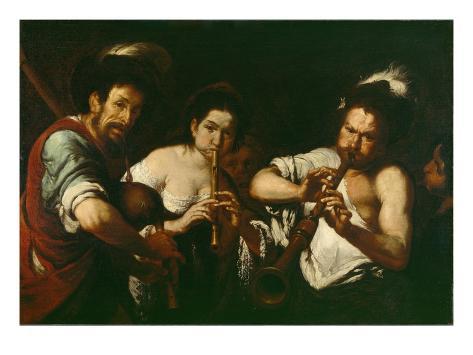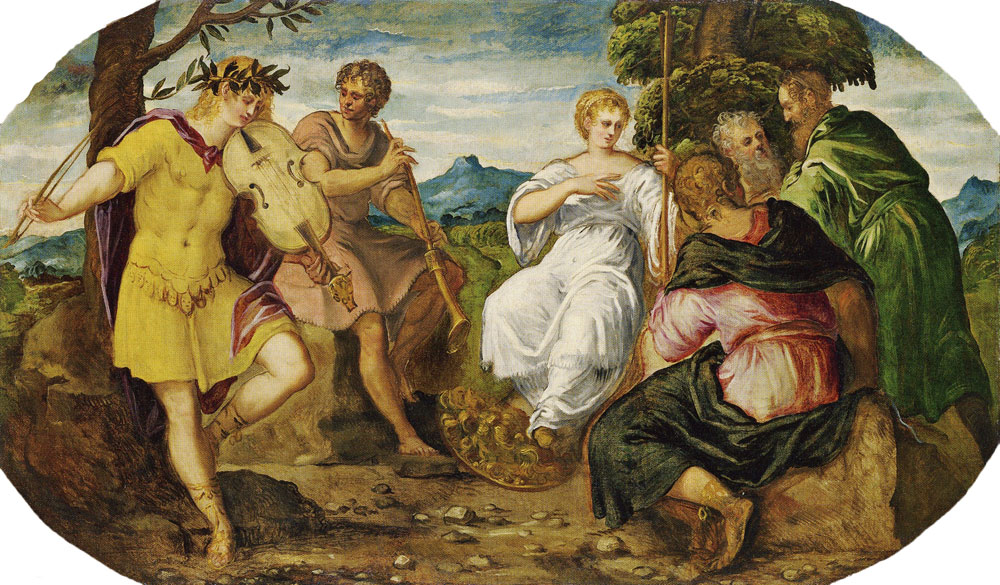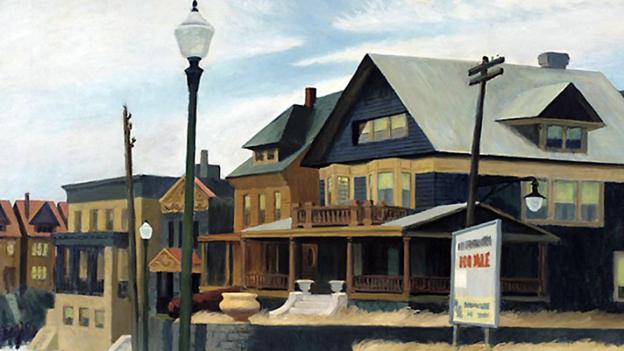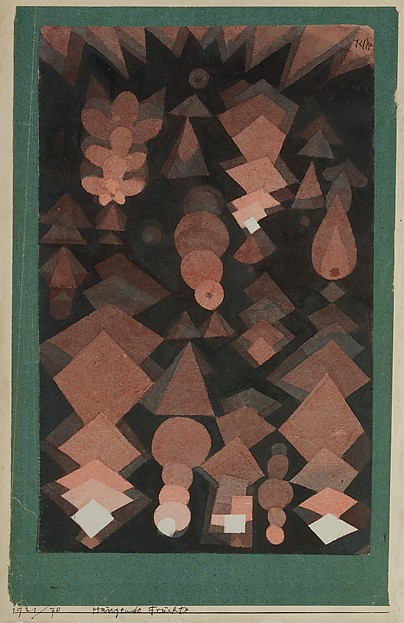From October 12, 2013, to January 19, 2014, the Montreal Museum of Fine Arts presents an innovative interdisciplinary exhibition, exploring for the first time the important interrelationships that exist between the visual arts and music in the Venetian Republic, from the early sixteenth century to the fall of the Serenissima at the close of the eighteenth century, a period during which these art forms served the political ambitions of the state and civic institutions and became increasingly central to the economy of the Republic.
Thanks to outstanding loans from prestigious museums and collectors, visitors to the exhibition
Spendore a Venezia: Art and Music from the Renaissance to Baroque in the Serenissima will discover the splendours of Venice through the musical scene: salons, where chamber music performances were featured, the elaborate carnevale, the theatre, street performances and the festive, costumed commedia dell’arte.
Featuring approximately 120 paintings, prints and drawings, as well as historical instruments, musical manuscripts and texts, this major exhibition paints a portrait of extraordinary artistic and musical creativity. This exhibition organized by the Museum brings together masterworks by many of the most renowned names associated with the city on the lagoon: visual artists directly associated with the musical life of the city include Titian, Tintoretto, Bassano, Giovanni Battista and Domenico Tiepolo, and Francesco Guardi, many of whom were also amateur musicians, as well as Bernardo Strozzi, Pietro Longhi and Canaletto, whose paintings record the role of music in Venetian life. The exhibition also includes manuscripts and publications by Venetian composers like the Gabrieli, Monteverdi, Albinoni, Lotti and Vivaldi, with several instruments.
“In Venice, in the same way that one cannot feel except in music, one cannot think if not in images,” wrote Gabriele D’Annunzio around 1900 in his flamboyant ode to Venice. As Museum Director and Chief Curator Nathalie Bondil explains, “At the Montreal Museum of Fine Arts, it is now equally impossible to see without listening, to listen without seeing. Two years after the opening of the Bourgie Concert Hall – a heritage building that also possesses acoustic properties – music has found its place front and centre at the Museum. Music has already played an essential part in our audacious and original major exhibitions for the past few years. First conceived of five years ago, when Bourgie Hall was no more than a dream… here is our latest production. Rather than being treated as mere accompaniment, music is fully integrated as part of a multidisciplinary dialogue about both artistic and historical content. This combination – a fine arts museum housing a professional concert hall run by a resident music foundation – is entirely unique.”
Exhibition curator Hilliard T. Goldfarb, Associate Chief Curator and Curator of Old Masters at the MMFA and a specialist of the Italian Renaissance, developed the concept of this original exhibition produced by the MMFA under the direction of Nathalie Bondil. The exhibition’s musical accompaniment is being overseen by musicologist François Filiatrault. Extensive associated programming created by Isolde Lagacé, General and Artistic Director of the Arte Musica Foundation, includes a series of concerts with period instruments in the MMFA’s Bourgie Hall.
The works on loan for this major exhibition – including precious historical instruments – have been contributed by sixty_one prominent international collections in Canada and abroad, including: from the United States – the Metropolitan Museum of Art, the Morgan Library & Museum, the New York Public Library, the Wadsworth Atheneum, the Cleveland Museum of Art, the National Gallery of Art (Washington); from Italy – the Palatine Gallery, Uffizi, Capitoline, Cini Foundation, Accademia (Venice), Museo Correr; from the rest of Europe – Vienna’s Kunsthistorisches Museum, Madrid’s Thyssen_Bornemisza, London’s Dulwich Picture Gallery and National Gallery, and the Louvre. From the beginning, the Cité de la musique in Paris has contributed to this exhibition with its scientific expertise and by loaning major instruments.
This exhibition will be circulated by the MMFA to the Portland Art Museum in Oregon from March 7 to June 8, 2014.
Visual arts, music and politics from the early sixteenth century to the fall of the Serenissima
The visual arts and musical scenes during the extraordinarily creative period from Titian to Guardi and Willaert to Vivaldi were profoundly interconnected. The world’s first public opera house (1637) opened in Venice, which boasted no fewer than nine commercial opera houses in the seventeenth and eighteenth centuries. Modern music typography was invented in Venice, and it was there that the most important musical presses in Europe were located. Public musical concerts were crucial to the economic strength of Venice’s scuole (rich, powerful brotherhoods) and ospedali (establishments for the poor and orphans). Each year, a variety of processions were held in celebration of special occasions. These were recorded in the visual arts and celebrated in music, in turn serving its government, which sponsored the arts. Music and the visual arts also became central to state propaganda and the Republic’s state receptions and international profile.
EXHIBITION THEMES
The exhibition is organized along three broad conceptual themes reflecting specific, parallel and interrelated characteristics of art and music during this critical period of Venetian history.
Art and Music in the Public Sphere
For Venice, steeped in classical and Medieval culture, music symbolized universal harmony and, by extension, good government. Music contributed to the splendour of civic commemorations, official celebrations and religious rites, and its role in the ducal chapel, public processions, churches, scuole, ospedali and other places central to Venetian life was immortalized by painters, printmakers and draftsmen.
Ceremonies and Processions
Music accompanied the ruling doge in processions announced by a fanfare of brass. In the chapel, he was extolled by wind, string and keyboard instruments and large choirs. This section presents a wide range of works, including a rare print of the procession of the doge that is over 4 metres long,
a portrait by Titian of Doge Francesco Venier:

Tiziano Vecellio, called Titian
(about 1488–1576)
Portrait of Doge Francesco Venier
About 1554–56
Oil on canvas
113 x 99 cm
Madrid, Museo Thyssen-Bornemisza
Inv. 1930.116 (405)
Photo © Museo Thyssen-Bornemisza, Madrid
Photo Fondazione Musei Civici di Venezia, Museo Correr
depictions of events at Saint Mark’s Basilica and the church of San Zanipolo, such as
Canaletto’s Interior of San Marco, Venice:
 Giovanni Antonio Canal,
Giovanni Antonio Canal,
called Canaletto (1697–1768)
Interior of San Marco, Venice
About 1760
Oil on canvas
44.1 x 31.5 cm
The Montreal Museum of Fine Arts
Adaline Van Horne Bequest
Inv. 1945.871
Photo MMFA, Brian Merrett
and Guardi’s The Papal Visit of Pius VI in the Church of S. Zanipolo, (Similar):

Pope Pius VI Blessing the People on Campo Santi Giovanni e Paolo
illustrating the role of the arts as interface between religion and politics.
Other objects include illuminated choir books, manuscripts and period instruments never before exhibited in North America, as well as costume pieces, including a corno ducale, the bonnet-like crown worn by doges on official occasions.
Scuole and ospedali
Venice was home to a network of scuole, rich, powerful brotherhoods that were sponsors and patrons of artists and musicians. Even more remarkable were the ospedali, establishments for the poor and orphans, renowned for their musical ensembles. Well known musicians like Vivaldi composed for these ensembles, enhancing their prestige. This section includes
Tiepolo’s The Coronation of the Virgin:
 Giovanni Battista Tiepolo (1696–1770)
Giovanni Battista Tiepolo (1696–1770)
The Coronation of the Virgin
About 1754
Oil on canvas
102.6 x 77.3 cm
Fort Worth, Texas,
Kimbell Art Museum
Inv. AP 1984.10
a rare oil sketch the artist used as a model for a ceiling fresco in the newly constructed church of the Pietà, Santa Maria della Visitazione, famed for its all-girl choir. Also on view:
Gabriel Bella’s concert scene Orphan Girls Singing for the Dukes of the North:

the first edition of The Four Seasons by Vivaldi, who taught violin at the Ospedale della Pietà, and
Canaletto’s wonderful Feast Day of San Roch, a special loan from the National Gallery in London:
 Giovanni Antonio Canal,
Giovanni Antonio Canal,
called Canaletto (1697–1768)
Venice: The Feast Day of Saint Roch
About 1735
Oil on canvas
147.7 x 199.4 cm
London, National Gallery
Inv. NG937
Photo © National Gallery, London / Art Resource, NY
Art and Music in the Private Realm
In the private domain, music was the art of the courtier and the educated class. Nobles were often portrayed playing the lute or composing, and thus identified with the values associated with music: philosophical speculation, scientific inquiry, intellectual and spiritual elevation. Contrary to the lowly pipes played by shepherds in pastoral or allegorical scenes, the instruments of the elite symbolized culture and were frequently ornamented with precious materials, as seen in the exhibited lutes, theorbos and harpsichords.
Musicians
Venetian portraiture often explored the musician as subject. Depicted alone or in groups, in allegorical, mythological or genre scenes, the figures appear in attire and with attributes that literally and figuratively reflect their dedication to music.
Titian’s great painting The Concert, on loan from the Palatine Gallery in Florence:
 Tiziano Vecellio, called Titian (about 1488–1576)
Tiziano Vecellio, called Titian (about 1488–1576)
The Concert (The Interrupted Concert)
About 1511–12
Oil on canvas
86.5 x 123.5 cm
Florence, Palazzo Pitti, Galleria Palatina
Inv. 1912 185
Photo Scala / Art Resource, NY
will feature prominently in this section. It is of particular interest as a masterpiece of Titian’s early maturity and for its art historical significance, which links the artist to his master, Giorgione.
Works like The Lute Player by Cariani, a disciple of Giorgione:
 Giovanni Busi, called Cariani
Giovanni Busi, called Cariani
(about 1485–after 1547)
The Lute Player
About 1515
Oil on canvas
71 x 65 cm
Musée des Beaux-Arts de Strasbourg
Inv. 236
Photo Musée des Beaux-Arts de Strasbourg, photo M. Bertola
Self-portrait with a Madrigal of Marietta Robusti (La Tintoretta, the daughter of Tintoretto):
 Marietta Comin (Robusti), called la Tintoretta
Marietta Comin (Robusti), called la Tintoretta
(1560–1590)
Self-portrait with a Madrigal
About 1580
Oil on canvas
93.5 x 91.5 cm
Florence, Galleria degli Uffizi
Inv. 1890, 1898
Photo Scala/Art Resource, NY
Annibale Carracci’s Portrait of Claudio Merulo:

and many other masterworks will illustrate the wide variety of styles and treatments.
Concerts
Music evolved on several fronts during the golden age of the Venetian Republic. Private concerts expanded to multiple instruments, and full orchestras were established to perform elaborate compositions. Venice was home to Europe’s leading music publishers, who thrived selling books of frottole (popular secular songs), lute tablatures and concerto scores for harpsichord, violin and other instruments. Songbooks like Ottaviano dei Petrucci’s extremely rare volume Odhecaton A (1501), the first musical score with movable type ever published and one of the greatest monuments in the history of publishing, promoted the practice of music and helped foster enlightened audiences. Venetian painters were distinguished by their passion for music, as seen in
Longhi’s Il Concertino:
 Pietro Longhi (1701–1785)
Pietro Longhi (1701–1785)
The Concert
1741
Oil on canvas
60 x 49 cm
Venice, Gallerie dell’Accademia
Inv. 466
Photo Cameraphoto Arte, Venice / Art Resource, NY
and other works in this section.
The love of all things musical is also evident in
A Still Life with Musical Instruments in an Interior by Evaristo Baschenis:

who is credited with inventing a new still_life genre featuring musical instruments (often Venetian_made) in pleasing arrangements.
Street Scenes
Music was not confined to the official, cultivated establishment. Lively popular songs were circulated by gondoliers and street performers, as captured in works like
Giacomo Franco’s Music on the Grand Canal
and Giovanni Battista Piazzetta’s The Singer:
 Giovanni Battista Piazzetta (1683–1754)
Giovanni Battista Piazzetta (1683–1754)
The Singer
About 1730
Oil on canvas
82.5 x 68.5 cm
Montpellier, Musée Fabre
Inv. 73.2.1
Photo Frédéric Jaulmes © Musée Fabre de Montpellier Agglomération
Manuscript songbooks for gondolas document the way various cultural communities influenced the repertoire. Music was also associated with carnevale, which transformed Venice into pure theatre in the Western imagination. The festive carnival spirit reigns in
Giovanni Domenico Tiepolo’s Minuet:
 Giandomenico Tiepolo
Giandomenico Tiepolo
(1727–1804)
The Minuet
1756
Oil on canvas
80.7 x 109.3 cm
Barcelona, Museu Nacional
d’Art de Catalunya
Francesc Cambó Bequest, 1949
Inv. MNAC 064989
Photo Calveras / Mérida / Sagristà
Strozzi’s Street Musicians:

and other open-air scenes.
Art, Music and Mythology
The world’s first public opera house, the Teatro Nuovo di San Cassian, presented its first opera production in Venice in 1637, and by the eighteenth century, the city boasted no fewer than nine such venues. Opera composers, from Monteverdi to Handel and Vivaldi focussed their hopes on seeing their works produced and published in Venice. Opera became a staple of social activity, and its production, a driving force in the Venetian Republic’s economy, provided jobs for set builders, costumers, stagehands, performers and countless others. At the same time, the classical mythology that inspired the creation of many librettos emerged in music-related painting.
Mythology
Italian Renaissance painting conveys a classical heritage marked by allegory, myths and symbols. Apollo, Venus and other deities are frequently pictured, and scenes from Ovid’s Metamorphoses inspired Titian throughout his career. But in Venice, there was the added factor of music. Music features in the Hypnerotomachia Poliphili, one of the greatest publications of the Renaissance, created in Venice in 1499 by the publisher, editor and printer Aldus Manutius.
Tintoretto’s monumental ceiling painting for Pietro Aretino, The Contest between Apollo and Marsyas:
 Jacopo Comin (Robusti),
Jacopo Comin (Robusti),
called Tintoretto (1518–1594)
The Contest between Apollo and Marsyas
About 1545
Oil on canvas
139.7 x 240 cm
Hartford, Connecticut, Wadsworth Atheneum Museum
of Art, The Ella Gallup Sumner and Mary Catlin Sumner Collection Fund
Inv.1950.438
Photo Wadsworth Atheneum Museum of Art / Art Resource, NY
is a superb example of the practice of combining themes associated with music.
The Concert of the Muses and other Goddesses, created as a painted harpsichord cover by Tintoretto,
as well as Sebastiano Ricci’s Vénus entourée de nymphes contemplant une ronde de cupidons, created for the same purpose:

will be presented.
Other works by Tintoretto, Tiziano Aspetti and
two wonderful Tiepolo paintings depicting the parting of Rinaldo and Armida:
 Giovanni Battista Tiepolo (1696–1770)
Giovanni Battista Tiepolo (1696–1770)
Rinaldo Abandons Armida
About 1753
Oil on canvas
39.6 x 61.9 cm
Berlin, Gemäldegalerie der Staatliche Museen,
Stiftung Preußischer Kulturbesitz
Inv. 2000.1
Photo Jörg P. Anders
inspired by the poem Gerusalemme Liberata of Tasso, a popular opera subject of the period and borrowed from the Gemäldegalerie in Berlin and the Uffizi in Florence, will be featured in this section.
Opera
Under the guise of allegorical and mythological figures, opera explored and reflected contemporary themes and issues. The number of public theatres grew rapidly as audiences embraced the new form of entertainment designed for eyes and ears alike. This enthusiasm will be illustrated by paintings, prints, drawings and sketches of well known singers and composers. A lovely pastel portrait of the great soprano Faustina Bordoni, as well as a delightful group of caricatures of Farinelli, Caffariello, Antonio Campioni and other famous opera singers by the Venetian artist, critic, printmaker and collector Antonio Maria Zanetti the Elder, will add a special touch to the exhibition. These drawings, never before exhibited in North America, offer a humorous and less formal view of the opera world.
Splendore a Venezia: An Extraordinary Musical Experience
For the exhibition Splendore a Venezia, the MMFA has produced a musical audioguide that is being made available to the public free of charge. This audioguide features one or more pieces of music in connection with a particular work of art or instrument. It goes without saying that a musical soundscape in the galleries, along the lines of those seen in MMFA exhibitions like Warhol Live (2008), Imagine: The Peace Ballad of John & Yoko (2009) and We Want Miles: Miles Davis vs. Jazz (2010), will complete this extraordinary musical experience.
A scientific book
To accompany this exhibition, the MMFA’s Publishing Department is publishing a full-colour exhibition catalogue, in English and French editions. The catalogue features essays by leading international experts in Venetian art, culture and music, under the general editorship of Dr. Hilliard T. Goldfarb: Tiziana Bottecchia, Dawson Carr, Francesca del Torre, Joël Dugot, Iain Fenlon, Caroline Giron, Jonathan Glixon, Sergio Guarino, Eugene Johnson, Piero Lucchi and Ellen Rosand. This publication serves as a reference work that makes an ongoing contribution to the body of knowledge on music and the visual arts in the private and public realms of the Venetian Republic. It is distributed by Hazan (French edition) and Yale University Press (English edition).
A Venetian layout designed by Guillaume Lord, including a gondola from the Guy Laliberté Collection
The layout of this exhibition was conceived by Guillaume Lord, a designer and creator of sets and props for the theatre, who has been active in his profession for some fifteen years both in Quebec and abroad in the fields of theatre, dance, circus, variety shows and musical comedies.
In this exhibition, where music is an essential part of the circuit, he has re_created an environment evoking the visitors’ journey in both time and space as they discover the legendary sights of Venice. Along the way they meet “Donatella” from the Guy Laliberté Collection and loaned for the occasion, traditional Venetian gondola crafted in the late-20th century by Pietro Amadi, composed of various woods, stainless steel and brass. On one side can be read the following inscription: In barca vien con mi (Embark with me).
The gondola, whose origins are lost in Venetian antiquity, is the traditional, flat-bottomed Venetian rowing boat that provides the ideal way to travel about the Venetian Lagoon. In the seventeenth and eighteenth centuries, it is estimated that between 8,000 and 10,000 of these watercrafts filled the Lagoon. Originally, gondolas could be painted different colours, but after 1562 they were restricted to black. In Canaletto’s time, the prow was lower and there were usually two rowers. The modern profile was developed in the nineteenth century by a builder whose descendants still construct these vessels. The city prohibited any further modification in the last century. Gondolas are now composed of 280 pieces made from 8 different types of woods. The left side (24 cm longer than the right side) is curved more to balance against the forward stroke of the oar at right that turns the vessel left. By regulation, all gondolas are exactly 10.87 metres long, 1.42 metres wide and weigh 700 kilograms (1,500 pounds). They are all entirely handmade.
An incredibly diverse musical programming presented in connection with the Exhibition
The MMFA and the Arte Musica Foundation, in residence at the Museum, combine their expertise and resources to present about 140 concerts in the Bourgie Concert Hall each year, welcoming an average of 45,000 spectators. Isolde Lagacé says: “The exhibition presented by the MMFA is the ideal occasion to make a foray into the incredibly rich world of Venetian music. From October to January, the Arte Musica Foundation will present 20 concerts in Bourgie Hall covering five centuries of music, both instrumental and vocal, sacred, profane and traditional.” She adds: “Although the exhibition focusses on the Renaissance and Baroque periods, the time limits have been pushed back to include the nineteenth century – with a literary and musical performance – and the twentieth century – with a soirée to pay tribute to two sons of Venice, Luigi Nono and Bruno Maderna – and the twenty-first century – with the creation of a musical fairytale for children with giant marionettes, Le Chat et le gondolier.”
The concerts include majestic choral works by Monteverdi and Gabrieli performed by the Studio de musique ancienne de Montréal; traditional songs for voice and lute with the Italian ensemble Accordone and the tenor Marco Beasley, who sang on the soundtrack of the film Tous les soleils; music for two organs; Italian arias and concertos performed by renowned Montreal ensembles and soloists; as well as two major works by Vivaldi; the Montreal premiere of the oratorio Juditha Triumphans with the Ensemble Caprice; and The Four Seasons with soloists and musicians from the OSM.
Credits and presentation of the exhibition
This exhibition has been developed, produced and circulated by Nathalie Bondil and its exhibition curator Hilliard T. Goldfarb. The Museum would like to thank the sixty_one lenders from Canada and abroad who contributed to this exhibition, which is presented under the high patronage of His Excellency Mr. Giorgio Napolitano, President of the Italian Republic.
The layout of this exhibition was conceived by Guillaume Lord under the direction of Sandra Gagné, Head of Exhibitions Production at the MMFA. Music is an integral part of the exhibition thanks to a specially designed original soundscape developed in close co_operation with the Arte Musica Foundation and François Filiatrault. Isolde Lagacé, also developed a special programme of lectures and concerts in connection with the exhibition for Bourgie Hall.
Also in the exhibition:
 Giovanni Antonio Canal, called Canaletto
Giovanni Antonio Canal, called Canaletto
(1697–1768)
The Bucintoro Returning to the Molo on Ascension Day
1760
Oil on canvas
58.3 x 101.8 cm
Dulwich Picture Gallery
Inv. DPG599
Photo By Permission of The Trustees of Dulwich Picture Gallery

Giovanni Antonio Canal, called Canaletto
(1697–1768)
The Bucintoro at the Molo
on Ascension Day
About 1745
Oil on canvas
114.9 x 162.6 cm
Philadelphia Museum of Art, The William L. Elkins Collection, 1924
Inv. E1924-3-48
Photo The Philadelphia Museum of Art / Art Resource, NY

Antonio Codognato (active 2nd half of the 18th c.)
View of the Magnificent Scenery and Lighting of the Teatro San Samuele
1753
Engraving
Sheet: 36.7 x 51.6 cm
Venice, Fondazione Musei Civici, Museo Correr,
Gabinetto dei Disegni e delle Stampe
Inv. ST. Correr 1081
Photo Scala / Art Resource, NY








































